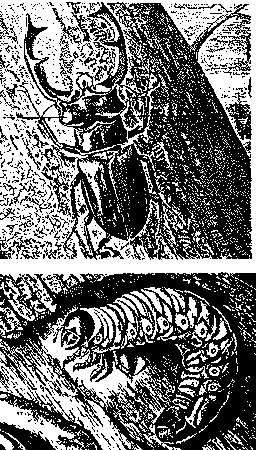 |
Science Frontiers ONLINE No. 100: Jul-Aug 1995 |
|
|
Anomalous Larvae And The Burning Of Heretics
 Adult and larval stages of a stag beetle. Could these radically different forms of the same species have had separate and different evolutionary histories? |
"Williamson has given us a new set of anomalies. Mostly he does this by showing that what we know doesn't fit together as well as we thought it did. In particular, the major phylogeny of the animal kingdom as estimated from adult characters doesn't fir very well with that estimated from larvae. Such a discrepancy for different stages has occasionally been reported within families of insects, and it has an apparent resemblance to the discordance occasionally found between phylogenies inferred from morphological and molecular characters. In such cases, the usual conclusion (I ignore data chauvinists) is that we should somehow use all the available information to infer the correct phylogeny. After all, there was just one real phylogeny that occurred in the past, and we want to find it as closely as we can."
Comment inserted by the compiler. Van Valen is saying that three evolutionary Trees of Life can be drawn from adult morphology, DNA structure, and larval morphology, and that they may not look the same. Caterpillars may yield a family tree different from that inferred from the butterflies. Which is correct, or are they all correct?
Back to the review. Waxing heretical, Williamson points out that an organism may have more than one phylogeny! Larvae may have ancestries different from the adults. How heretical can one get? But in the ocean, spermatozoa often cannot find an egg of the correct species. They may then fertilize eggs of a distantly related species. In such "wide hybrids," the larvae may resemble one parent and the adults the other.
There is much more. The gist of it all is that evolution has been much more than random mutation and natural selection. Hybridization and outright mergers (endosymbiosis) have played important roles. Even our own cells harbor mitochondria that have their own DNA. They are probably bacterial invaders that long ago settled down in the cells of our ancestors.
(Van Valen, Leigh M.; "Anomalous Larvae and the Burning of Heretics," Evolutionary Theory, 10:279, 1994. Cr. K.L. Partain.)